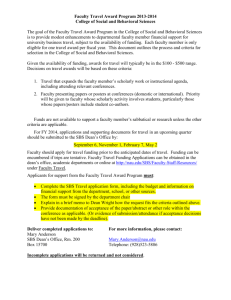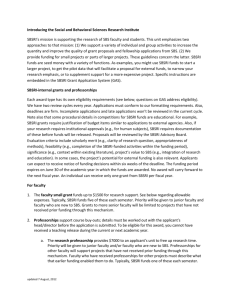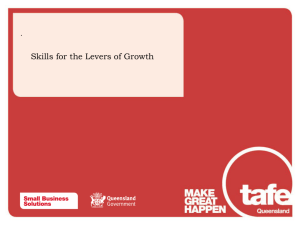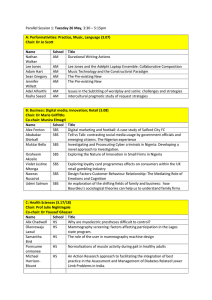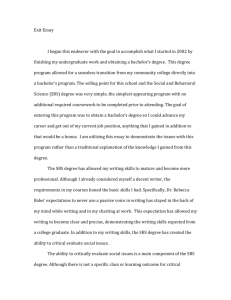Digital Radio Discussion Paper
advertisement
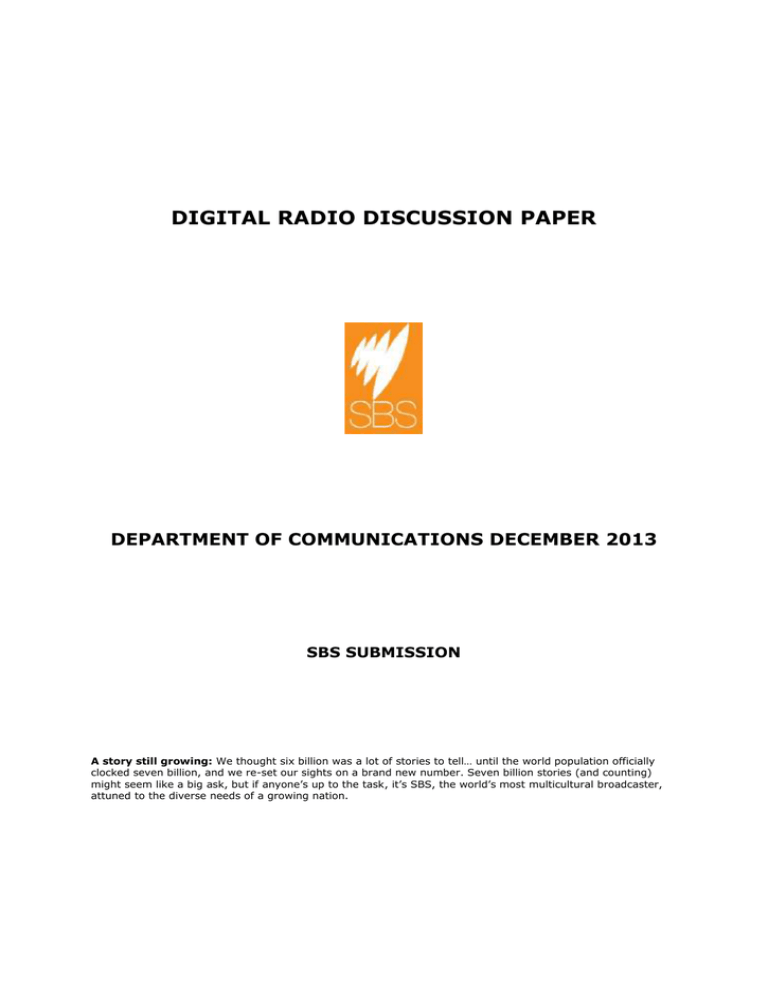
DIGITAL RADIO DISCUSSION PAPER DEPARTMENT OF COMMUNICATIONS DECEMBER 2013 SBS SUBMISSION A story still growing: We thought six billion was a lot of stories to tell… until the world population officially clocked seven billion, and we re-set our sights on a brand new number. Seven billion stories (and counting) might seem like a big ask, but if anyone’s up to the task, it’s SBS, the world’s most multicultural broadcaster, attuned to the diverse needs of a growing nation. Introduction SBS welcomes the opportunity to provide information to the Department in response to the Digital Radio Discussion Paper (December 2013). SBS is Australia’s multilingual and multicultural national broadcasting service, operating under the Special Broadcasting Service Act 1991 (SBS Act). Our principal function is to provide multilingual and multicultural radio, television and digital media services that inform, educate and entertain all Australians, and, in doing so, reflect Australia’s multicultural society. Our purpose is to inspire all Australians to explore, appreciate and celebrate our diverse world, and by doing so contributes to a cohesive society. SBS Radio plays a crucial role in achieving these objectives and serving Australia’s diverse language communities. It is the most linguistically diverse radio network in the world, broadcasting in 74 languages across Australia (Attachment 1). SBS Radio assists these communities to participate as fully as possible in Australian society by providing balanced and impartial Australian and international news and information in-language. It also supports the maintenance and development of cultural identity and maintains crosscultural links. While exploring issues relevant to all Australians, SBS Radio fulfils different roles, including information provider, news source, entertainer, educator, cultural vehicle, commentator and a medium for diverse community voices. SBS Radio is broadcast on analog and digital radio, digital television, as well as via streaming and podcasting online. SBS Radio’s analog services are available on five analog networks – AM/FM in Sydney (including Canberra and Wollongong) and Melbourne, and a national service. SBS Radio transmits eight digital services to Adelaide, Brisbane, Canberra (trial), Melbourne, Perth and Sydney. The Value of Digital Radio Digital radio is a vital component of the future of broadcasting in Australia. Digital radio provides the opportunity to expand the range of radio services across Australia, and also to enhance the nature of those services. The additional benefits of digital radio which are not being utilised at present include image slide shows, traffic and travel information 1 and interactive features. For SBS, digital radio currently provides an opportunity to complement its existing analog services. More importantly, it also provides a digital future for the radio industry and the potential for SBS to expand its reach into regional Australia, which is currently severely limited by its lack of radio transmission infrastructure. Only around 19 per cent of Australia’s regional population can receive SBS’s radio services on terrestrial radio transmitters (see Attachment 2).2 Digital radio has the capacity to provide an efficient means to provide accessible, equitable and low cost services to audiences in regional Australia and address the serious imbalance in the availability of SBS Radio’s services to culturally and linguistically diverse communities throughout Australia. SBS notes that the report of the Department of Broadband, Communications and the Digital Economy, ‘Review of technologies for digital radio in regional Australia’, confirmed See TPEG – Transport Protocol Experts Group, http://www.mcbld.com/tisa.org/technologies/tpeg/ ABS, 2011 Census. Proportion of inner regional, outer regional, remote, and very remote population centres’ (see abs.gov.au/ausstats/abs@.nsf/Products/3218.0~201112~Main+Features~Main+Features?OpenDocument). SBS considers this to be an over-estimation. 1 2 Seven Billion Stories and counting… 2 the ‘desire of the radio industry, organisations and members of the public to see digital radio rolled out to regional areas of Australia’ as soon as practicable.3 Alternatives to digital radio terrestrial services have their limitations. While listeners in regional Australia can receive SBS Radio services via their VAST television, this does not provide the same mobility as a terrestrial radio receiver, nor the ability to purchase more than one receiver cheaply. SBS also streams its language programs online and provides podcasts through the SBS Radio Your Language app. However SBS does not consider online services provide an equitable alternative to terrestrial services as they require online access, involve download costs, and are not accessible to audiences who lack digital literacy.4 Planning for the Future of Digital Radio in Australia While digital radio has the potential to provide a means of providing more enhanced radio services to audiences in Australia, the planning process has stalled. SBS is of the view that in order to take advantage of the benefits of digital radio, Australia must start preparing for analog radio switch off as soon as possible. As the Discussion Paper notes, in Norway the analog FM broadcasting is scheduled to switch- off in January 2017 provided certain conditions are met. Norway saw a 140 per cent year-on- year take up of digital radio receivers in 2013, much of which was attributable to the introduction of a new national broadcaster station from NRK, which is only available via DAB+.5 Denmark has also committed to analog radio switch off, and SBS understands Germany and France are also preparing to set switch off timetables. The UK has implemented a process for digital switchover. While the actual switchover date will depend on certain criteria being met, SBS notes that in December 2013, the Government announced a package of measures to aid the industry and encourage consumers to migrate to digital.6 Further, in preparation for digital switchover, the radio industry in the UK has developed policy and planning documents covering a comprehensive range of policy issues including: communications strategy, switchover costs, phased versus singular switchover, environmental disposal of obsolete receivers, energy consumption impacts, travel and traffic services, and consumer willingness to upgrade and pay for a digital receiver.7 In comparison Australia lacks a long-term plan for the future. SBS considers it would be helpful for the Government to convene an industry-led forum group to start planning the rollout of digital radio. One of the first objectives of the forum would be to plan a switchoff date for analog radio. In addition, industry and government should work together to drive take-up of digital radio, promoting its advantages, including improved quality, augmented content and user-centric applications. Unlike analog television, there is no digital dividend to be gained from re-farming analog radio spectrum. However there are considerable efficiencies to be gained by adopting a DBCDE Review of technologies for digital radio in regional Australia – Final Report (2011), p. 21 See for example: Leung, L. Mind the Gap: refugees and communications technology literacy (Australian Communications Consumer Action Network, Sydney, 2011), p. 1, accan.org.au/files/Reports/Mind%20the%20Gap%20ACCAN-UTS.pdf 5 Irwin, D ‘DAB+ Gains Widespread Acceptance in Norway’ Radio Magazine (5 February 2014), radiomagonline.com/digital_radio/dab_gains_widespread_acceptance_in_norway_0205/ 6 UK House of Commons Library, Standard Note: SNHA2564 (20 December 2013), parliament.uk/business/publications/research/briefing-papers/SN06524/digital-radio-switchover 7 Department for Culture, Media and Sport (UK) ‘Digital radio action plan and association documents’ gov.uk/government/collections/digital-radio-action-plan-and-associated-documents 3 4 Seven Billion Stories and counting… 3 more pro-active approach to digital radio switchover including savings on the costs of operational duality and energy efficiencies. SBS would expect any regional roll-out plan to broadly follow a population priority basis across multiple states. In parallel, a program of low-power infill would be rolled out to provide near ubiquitous coverage within each defined market; as has more recently been the case in the Sydney, Melbourne and Brisbane markets (using low-power on-channel repeaters). The 2018 Commonwealth Games, being hosted in the Gold Coast (4-15 April), present an excellent opportunity to promote and showcase DAB+ services and related applications and drive consumer take-up. Spectrum and Licensing Issues VHF Band III (174-230MHz) SBS considers that DAB+ in VHF Band III should be the primary platform for digital radio expansion throughout Australia. DAB/DAB+ is the only proven and mature digital radio technology with widespread international support for which receivers are readily and widely available at low to moderate price points. It presents the most viable technology for coverage of all metropolitan areas, regional centres and towns in Australia in the medium term. As part of the consultation process relating to the spectrum restack review and in submissions to the review of technologies for digital radio in regional Australia, SBS, together with many others in the broadcast radio and transmission industries, highlighted the need for an allocation of 21MHz of Band III spectrum to overcome spectrum congestion in major markets adjacent to the metropolitan areas – particularly Sydney, Melbourne and Brisbane.8 In the case of Sydney, the adjacent markets of Wollongong, Central Coast and Newcastle will present significant potential signal overlap and therefore restrict the re-use of the limited spectrum allocated to DAB. Similar adjacency situations exist between the seven radio markets which surround Brisbane and the markets surrounding Melbourne. However the Broadcast Services Band (BSB) replanning associated with the digital television spectrum restack program 9 reserved only two 7MHz radio frequency channels in the VHF Band III block for DAB+ digital radio (channels 9 and 9A). These two 7MHz blocks allocate 14MHz of contiguous spectrum (195-209MHz) to DAB+ services and enable the allocation of eight digital radio ‘ensembles’ or muxes. As a result, very careful and detailed planning, and compromises, will be required in order to optimise the range and reach of services available to the adjacent regional markets when compared to the suite of existing metropolitan DAB+ services. SBS is firmly committed to the principle of equity of access to services and that its services should be available to all Australians. SBS would not support a national broadcaster mux allocation regime that does not provide equality of service choice across all markets. DBCDE, n 3 above; ACMA, Five-year Spectrum Outlook 2012-2016, acma.gov.au/theACMA/draft-ifc-2012-t02016-fyso 9 This program involved compacting the use of the Band III and UHF spectrum for digital television in anticipation of (and subsequent) closure of analog television services to release a contiguous block of spectrum for auction. 8 Seven Billion Stories and counting… 4 The channel allocation of digital television under a ‘block’ regime and a prior determination that ‘Channel 13’ (230-237MHz) could not be allocated to DAB services, due to the potential to cause interference to defence communications systems, precluded the provision of additional Band III spectrum for DAB use. Until such time as a further restack of digital television spectrum through the adoption of next-generation standards frees up additional Band III spectrum, the reservation of only 14MHz of spectrum imposes significant operational and programming diversity restrictions on broadcasters. To address these issues, SBS proposes that the national broadcaster mux be operated as a wide-area SFN. This will require the suite of national broadcaster DAB+ services carried on the mux to be identical across the macro-regional area. Under this scenario it would be necessary for the ABC Local Radio service to be carried as part of a Category 2 mux, using its entitlement under the current access regime Further complexity arises in the overlap markets of northern NSW and Gold Coast which will require detailed study to assess options and feasibility. In the UK, the BBC national services are carried in a single mux as a nationwide SFN in channel 12B. Digital One, the commercial national mux, is similarly carried as a widearea SFN, uses channel 12A in Scotland (due to international frequency coordination issues) and uses channel 11D across the rest of the UK. BBC local radio services are carried on a local mux, together with commercial services – under a similar arrangement to a Category 2 mux. Given the Australian experience of wide-area SFN operation in the television domain, and the UK DAB SFN experience cited above, it will be imperative to undertake detailed planning on a holistic basis to obtain optimum reach and equality of program diversity (vis-a-vis the metropolitan markets) in the limited spectrum available. Attachment 3 provides a table showing the DAB channel nomenclature in relation to Band III spectrum and the traditional television channel listings. L-Band (1452-1492MHz) There have been a number of national L-Band deployments of DAB, most notably in Canada and Germany. For reasons of coverage as well as a variety of mainly local issues, these L-Band deployments have not been successful and have not seen widespread consumer acceptance. This has, in turn, contributed to the current lack of L-Band/Band III receivers internationally. Although the L-Band spectrum (1452–1492MHz) has been reserved for DAB allocation in Australia, parts of this spectrum block are currently used for fixed links by Optus and other telecommunications services. The reception range of L-Band transmissions is generally less than that for VHF Band III transmissions and DAB deployment in this band would therefore require a denser network to provide adequate coverage in an urban and suburban environment. The usefulness of this spectrum block is further compounded by the lack of suitable, lowentry price point receivers – due to the limited global market use of L-Band and no planning options to provide sufficient spectrum clearance to enable its utilisation in Australia in the foreseeable future. SBS therefore considers the potential usefulness of this spectrum block to augment VHF DAB services to have significantly declined. This spectrum block would be of likely Seven Billion Stories and counting… 5 interest and value to the telecommunications sector for fixed (and possibly nomadic) services. In 2010, the European Conference of Postal and Telecommunications Administrations (CEPT) undertook a review of the use of 1452-1492 MHz band and determined that the most appropriate regulatory framework for future use in the CEPT region is the harmonisation of this band for mobile broadband/mobile supplemental downlink (SDL), while allowing individual countries to adapt to specific national circumstances in part of the band for terrestrial broadcasting and other terrestrial applications.10 This regulatory framework brings the highest benefits for CEPT, with those benefits being maximised when mobile supplemental downlink is deployed under this framework. On a global scale, recommendations made by the CEPT will also influence discussions and work on the harmonisation of spectrum for mobile broadband that will be undertaken by the International Telecommunication Union – Radiocommunication (ITU-R) at the next World Radio Conference (WRC) in 2015, which are likely to have implications for (ITU) Region 3. A chip set is now in development by Qualcomm to provide a Mobile Supplemental Downlink capability for use in L-Band by 2015.11 SBS postulates that reallocation of the L-Band spectrum block to other telecommunications or IMT-related services through auction may provide a significant source of funding which could be deployed to support the development of national / large-scale regional infrastructure for DAB+ roll-out. Mux Access Regime and Quality Standards Given the range of coding and error-protection parameters available to broadcasters utilising a share of a mux, SBS suggests that mux capacity allocation should be defined in ‘Capacity Units’ rather than in multiples of ‘one-ninth’ of the mux as is currently the case. This will make sharing of aggregate bit-rate more straightforward to define and calculate in the future. This will be particularly relevant if, as suggested above, a Category 2 mux is utilised to carry the ABC’s Local Radio Service. SBS strongly supports the need for a minimum bit-rate to be defined so as to ensure a minimum quality performance (in digital mode) for all broadcast audio services carried on the DAB+ platform (and other future platforms such as DRM30 that may emerge over time). In the UK, audio quality on the DAB platform is considered by many to be inferior to that of FM. To a significant extent this is due to the use of the legacy DAB standard adopted in the UK (as an early adopter), whereas Australia took a lead role in the development of a higher efficiency encoding standard which was incorporated into the standard by ETSI and adopted in Australia as DAB+. In the UK broadcasters are faced with a trade-off between quality and quantity given the much lower encoding efficiency. In order to take advantage of the benefits of digital radio, SBS therefore strongly submits that there needs to be a defined lower limit in terms of subjective audio quality to ensure Australian audiences are not subject to retrograde quality in the transition to an all-digital radio environment. This threshold should be determined by the Australian radio industry. A technique to provide additional HSPA+ and LTE-Advanced download capability by aggregating spectrum capacity with LTE-paired spectrum. Refer Attachment 4 for further information. 11 Youell, T ‘Qualcomm to develop SDL chip for L-band’ Policy Tracker: The Spectrum Management Newsletter, policytracker.com/free-content/blogs/toby-youell/editorial-qualcomm-to-develop-sdl-chip-for-l-band 10 Seven Billion Stories and counting… 6 Spectrum Planning The experience of the metropolitan DAB rollout in 2009 was that the spectrum planning activities commenced late in the process, and this impacted on the timing of certain activities; for example, antenna procurement in some cases. The complexities associated with making best use of the limited 14MHz reserved block of Band III spectrum will require very detailed, careful and timely planning to provide an optimal mix of coverage and diversity of content. SBS recommends that when planning commences for regional rollout, the planning analysis consider not only the traditional ‘low-density’ network (of high towers and medium/high power) with its associated overspill issues into adjacent areas, but also model the development of a low-power, ‘high-density’ network similar to the mobile telecommunications networks. The high-density option would be predicated using a significant number of telecommunication base-station towers with low-to-medium power transmitters, configured as a wide-area SFN. This model could allow considerably better contouring of required coverage than that of the traditional network, however, consideration would need to be given to minimise adjacent channel interference to digital television services, perhaps through the deployment of low-power DTV on-channel repeaters. The UK wide-area SFNs have required careful planning and subsequent adjustment to provide and maintain optimum coverage as additional transmitters are added as part of ‘in- fill’ expansion. Given the complexities of this task, SBS considers it essential that the ACMA be tasked to commence a detailed planning analysis for industry review, in preparation for the expansion of DAB services into the regional markets. Technological Environment DAB platform is under-developed The DAB platform, at a global level, is significantly under-developed in respect of the market- place offerings to consumers (reception devices, their functionality and the applications provided by the broadcasters). The DAB+ platform (based on the Eureka 147 standard) has considerable potential to differentiate over the legacy analog platforms but that potential is not being realised for a number of reasons. Limited bandwidth (in Australia and the UK) has, to a significant extent, precluded the provision of rich multi-media data applications in favour of audio program content as a result of capacity scarcity. While radio industry bodies have been proactive in stimulating the receiver industry and product development, there has been a lower than expected number of receivers in the market that would support the advanced functionality that would differentiate DAB+ over its analog counterparts. Satellite digital radio The satellite pay-radio networks of Sirius and XM, which subsequently merged in 2008, have not been commercially successful in the US and Canada despite an aggregate Seven Billion Stories and counting… 7 population (potential audience) size of about 350 million. The subscriber base of these services was reported at 25.6 million in January 2014. In South Korea, a Digital Multimedia Broadcasting (DMB) satellite service was launched in 2005 by TU Media, a subsidiary of SK Telecom (the leading Korean mobile telco) utilising S-Band spectrum (2170-2200 MHz) to provide national coverage (S-DMB). However this platform required a significant augmentation of thousands (estimated in the range 5,000–9000) of land-based repeaters to provide coverage in urban areas due to the screening in the ‘concrete canyons’ of CBD environments which blocks line-of-sight reception of the satellite signals; the terrestrial repeaters also help provide indoor coverage in urban areas. The business performance moved into serious decline from 2009 and in 2012 TU Media returned its licence to the KCC (regulator). A case study analysis of the failure of S-DMB and difficulties also faced by the free-to-air T-DMB (terrestrial platform, using L-Band spectrum) purports that regulatory divergence across platforms, despite the similarity between the audience product, was a significant contributory factor.12 SBS submits that the relatively low population of Australia, together with its strongly urbanised environments and significant radio diversity in small markets would not support a subscription satellite radio platform. DRM and DRM+ SBS supports the deployment of DAB+ in VHF Band III as the primary platform for digital radio throughout Australia in the medium term. However, consideration needs to be given to the eventual digitisation of the analog broadcasts in the MF spectrum block which provide wide-area coverage. A DRM transmission standard would offer considerable electrical conversion efficiency compared to its current amplitude modulation (AM) counterpart, particularly at high power sites. The major drawback to adopting this standard at present is the lack of available receivers. Earlier initiatives to adopt high-power MF wide-area transmissions using DRM30 in Europe, to provide extensive coverage of Western Europe with ‘near FM quality’ audio came to nothing. Other initiatives, such as All India Radio’s statement of intent to convert its national network of MF transmitters, are yet to materialise. SBS recommends that a ‘watching brief’ be maintained by industry at this time pending adoption by a large population country/region to stimulate receiver development and mass production. ISDB-T and IBOC SBS does not support the introduction of the ISDB-T and IBOC radio standards into the Australian marketplace. Neither technology has the level of global (or wide regional) penetration, nor mass market product choice or maturity and price-point advantages compared to that of DAB/DAB+. DAB+ has become the established standard for digital radio in Australia, and a fragmentation of VHF transmission and encoding standards would lead to consumer confusion and the need for multiple receivers, at least in the short term, in order to receive digital radio broadcasts. Sohn, S ‘How Some Regulatory Policies can Undermine the Success of a New Technology: A Case Study of Digital Multimedia Broadcasting in South Korea’ Keio Communication Review No. 35, 2013, mediacom.keio.ac.jp/publication/pdf2013/seunghye.pdf 12 Seven Billion Stories and counting… 8 IBOC is also technically inferior, particularly in respect of its potential to cause interference to adjacent channel services, especially when deployed in MF spectrum. IBOC was originally developed as a hybrid system, as an ‘add-on’ to existing AM and FM transmissions, albeit requiring additional bandwidth and, as a result, has the propensity to cause interference. LTE – mobile broadband Although LTE mobile technology can deliver ‘broadcast/multicast’ services (eMBMS – LTE Multimedia Broadcast Multicast Service), there are limitations: they are not free-to-air, and regular listening will very quickly consume a typical monthly personal data plan; coverage is limited to the extent of the telecommunications network deployment; they are spectrally very inefficient as content would need to be duplicated across all three carrier networks (Vodafone, Optus and Telstra); if all radio services were to be carried on the LTE network, the current capacity limitations of the network would soon be exceeded and would require significant capex upgrade. A Teracom White Paper has found that the use of LTE as an alternative platform to broadcast radio is not a commercially viable alternative.13 Online and other platforms SBS agrees with the point made in the Discussion Paper that the rapid growth of alternative platforms for radio services will impact on the industry but the exact nature of the impact is difficult to predict. SBS does not consider online or mobile platforms as alternatives to its terrestrial services. SBS Radio currently streams its language programs online and provides podcasts through the SBS Radio Your Language app. These platforms are used to expand the reach of SBS Radio’s services and complement SBS’s analog and digital terrestrial radio services. Alternative platforms such as online and mobile platforms do not currently provide an equitable alternative to terrestrial services due to the extra costs involved and digital literacy issues. Other matters Metropolitan infill In respect of metropolitan infill, currently the SBS and ABC (national broadcasters’ mux) are materially disadvantaged compared with the commercial mux operators. Additional funding would enable the national broadcasters to benefit from the infill repeaters installed by Commercial Radio Australia and its joint venture (CRA-JV) partners. These repeaters14 have been procured at CRA-JV expense to provide infill coverage benefits to the commercial muxes, however, they cause interference to the adjacent Teracom, ‘Teracom White Paper: Can the cellular networks cope with linear radio broadcasting?’ (November 2013), digitalradio-oesterreich.com/static/download/Teracom_WhitePaper.pdf 13 Seven Billion Stories and counting… 9 national broadcaster services. Under a ‘polluter-pays’ principle, the CRA-JV has also funded corresponding adjacent channel repeaters which are currently operated solely at sufficient power to restore the national broadcaster services in the immediate environment surrounding the repeater and no more. Although these adjacent channel repeaters are capable of being run at a higher power level, to equal that of the commercial mux, these are currently operating at 1/100th (or -20dB) solely to address the interference issue. At this power level, the SBS and ABC do not obtain any material coverage infill benefit. With extra funding, SBS and ABC could contribute to the capital and operational cost of the infill equipment and obtain the benefit of equal transmitted power and ensure equality of service across the metropolitan market, particularly to overcome differential drop-out for in-car listeners when driving through these blackspot ‘islands’. Canberra and Darwin trials SBS submits that these trials should be replaced by permanent services. This would represent the first stage of a digital radio regional roll-out. The findings from the trials will provide invaluable input to the planning process. Conclusion The opportunities digital radio can provide for audiences in regional Australia should not be overlooked. The rollout of digital radio services in regional Australia would provide a means to redress the imbalance in the availability of SBS Radio’s services to culturally and linguistically diverse communities throughout Australia in comparison to metropolitan audiences. The advantages include providing a means to contribute to meeting the communication needs of Australia’s multicultural society and contributing to the retention and continuing development of language and other cultural skills, both vital for supporting Australia’s migration policies and contributing to an inclusive and cohesive society. In order to take advantage of the enhanced communication services provided by digital radio, the Government and industry should work together to plan the rollout of digital radio in regional Australia, plan a switch off date for analog radio and drive take-up of digital radio, promoting its advantages, including improved quality, augmented content and user- centric applications. Brisbane = 1 off; Melbourne = 3 off; Perth = 1 off and Sydney = 6 off. Source: ACMA Radio and Television Broadcasting Stations (Jan 2014). 14 Seven Billion Stories and counting… 10 Attachment 1 SBS Radio Services SBS Service Analog Digital Other SBS Radio 1 (AM service) Sydney Canberra Wollongong Melbourne Adelaide Brisbane Melbourne Perth Sydney Canberra (trial) Online – sbs.com.au/radio/ Sydney Canberra Melbourne Adelaide Brisbane Melbourne Perth Sydney Canberra (trial) Online – sbs.com.au/radio/ N/A Adelaide Brisbane Melbourne Perth Sydney Canberra (trial) Online – sbs.com.au/radio/ Adelaide Brisbane Melbourne Perth Sydney Canberra (trial) Online – sbs.com.au/radio/ Adelaide Brisbane Melbourne Perth Sydney Canberra (trial) Online – sbs.com.au/radio/ Adelaide Brisbane Melbourne Perth Sydney Canberra (trial) Online – sbs.com.au/radio/ Adelaide Brisbane Melbourne Perth Sydney Canberra (trial) Online – sbs.com.au/radio/ Adelaide Brisbane Melbourne Perth Sydney Canberra (trial) Online – sbs.com.au/radio/ N/A N/A SBS Radio 2 (FM service) SBS Radio 3 SBS Radio 4 SBS Chill SBS PopAraby SBS PopDesi SBS PopAsia National Radio Network (NRN) N/A N/A N/A N/A N/A See Attachment 2 Mobile – SBS Your Language app Mobile – SBS Your Language app Mobile – SBS Your Language app Mobile – SBS Your Language app Mobile – SBS Your Language app Mobile – SBS Your Language app Mobile – SBS Your Language app Mobile – SBS Your Language app SBS Radio Language Programs African Seven Billion Stories and counting… 11 Albanian Amharic Arabic Armenian Assyrian Bangla Bosnian Bulgarian Burmese Cantonese Cook Islander Maori Croatian Czech Danish Dari Dinka Dutch Estonian Fijian Filipino Finnish French German Greek Gujarati Hebrew/Yiddish Hindi Hmong Hungarian Seven Billion Stories and counting… 12 Indonesian Italian Japanese Kannada Khmer Korean Kurdish Lao Latvian Lithuanian Living Black (Aboriginal) Macedonian Malay Malayalam Maltese Mandarin Maori Nepali Norwegian Pashto Persian Polish Portuguese Punjabi Romanian Russian Samoan Serbian Sinhalese Seven Billion Stories and counting… 13 Slovak Slovenian Somali Spanish Swahili Swedish Tamil Tigrinya Thai Tongan Turkish Ukrainian Urdu Vietnamese World News Seven Billion Stories and counting… 14 Attachment 2: List of SBS Radio transmitters in regional Australia1 Area Served New South Wales Balranald Bathurst Batlow Berridale Boggabilla Boorowa Bourke Brewarrina Broken Hill Cobar Coolamon Cooma Coonabarabran Coonamble Cootamundra Corowa Cowra Culcairn Deniliquin Dubbo Gilgandra Glen Innes Griffith Seven Billion Stories and counting… 15 Gulargambone Gulgong Gundagai Gunnedah Town Holbrook Ivanhoe Jerilderie Jindabyne Junee Lightning Ridge Lismore Lithgow Long Flat Menindee Merriwa Moama Mudgee Town Mungindi Murrin Bridge Murrurundi Muswellbrook Narrabri Narrandera Narromine Nimbin Nyngan Oberon Orange Parkes Seven Billion Stories and counting… 16 Peak Hill Port Macquarie Quirindi Tumbarumba Tumut Walcha Walgett White Cliffs Wilcannia Wyalong Young Northern Territory Darwin* Nhulunbuy Queensland Airlie Beach Alpha Aramac Ayr Badu Island Bedourie Birdsville Blackall Bollon Boonah Boulia Cairns (Mt Yarrabah) Canungra Carmila Seven Billion Stories and counting… 17 Clairview Clermont Cloncurry Cow Bay Cunnamulla Daintree Dajarra Dingo Beach Dirranbandi Eidsvold Emerald Eromanga Eulo Glenden Hughenden Hungerford Injune Jericho Jundah Kooralbyn Longreach Meandarra Monto Moonford Moranbah Mossman Murray Island Group Muttaburra Nebo Seven Billion Stories and counting… 18 Port Douglas Proserpine Quilpie Rathdowney Richmond Sapphire Shute Harbour Speewah Springsure St Lawrence Stonehenge Tambo Tara Taroom Thallon Thargomindah Theodore Windorah Winton Wondai Wyandra Yowah South Australia Coober Pedy Maluku Kuru Mintabie Naracoorte Renmark Roxby Downs Seven Billion Stories and counting… 19 Woomera Wudinna Tasmania Hobart* Queenstown Rosebery Strahan Victoria Ballarat (Warrenheip) Benalla Bendigo Hamilton Maryborough Mildura Morwell Myrtleford Wodonga Western Australia Bridgetown Broome Coorow Denmark Exmouth Green Head Hopetoun Merredin Moora Morawa Pingelly Seven Billion Stories and counting… 20 Ravensthorpe Wandering Westonia Wongan Hills * SBS service. All other services are retransmission (self-help) services. Notes 1. As at March 2014. Regional Australia defined in ‘Australian Statistical Geography Standard (ASGS): Volume 5 – Remoteness Structure’ (ABS, July 2011), see abs.gov.au/AUSSTATS/abs@.nsf/DetailsPage/1270.0.55.005July%202011?OpenDocument. Seven Billion Stories and counting… 21 Attachment 3: DAB Channel Plan European TV Channel Australian TV Channel DAB Block A DAB Block B DAB Block C DAB Block D 5 6 5A 174.928 5B 176.64 5C 178.352 5D 180.064 6 7 6A 181.936 6B 183.648 6C 185.36 6D 187.072 7 8 7A 188.928 7B 190.64 7C 192.352 7D 194.064 8 9 8A 195.936 8B 197.648 8C 199.36 8D 201.072 9 9A 9A 202.928 9B 204.64 9C 206.352 9D 208.064 10 10 10A 209.936 10B 211.648 10C 213.36 10D 215.072 11 11 11A 216.928 11B 218.64 11C 220.352 11D 222.064 12 12 12A 223.936 12B 225.648 12C 227.36 12D 229.072 Seven Billion Stories and counting… 22 Attachment 4: Mobile Supplemental Downlink – An Overview Mobile Supplemental Downlink (Mobile SDL) is a mobile broadband system, which by means of base station transmitters in the network, is able to use unpaired spectrum to provide a supplemental downlink capacity to carry efficiently comprehensive text, audio, images, sound and video content in unicasting, multicasting and/or broadcasting mode to mobile devices. Mobile SDL uses a wider channel for the downlink than for the uplink, by bonding the usual downlink of the paired (FDD) mobile bands with a supplemental downlink channel(s). The harmonisation of the 1452-1492 MHz band unpaired spectrum for Mobile SDL is important to enhance the downlink capability of mobile broadband systems and represents a strategic tool to tackle the growing mobile data traffic asymmetry. With such an appropriate regulatory framework in place, the ECC intends to provide guidance and certainty to the industry so that the UMTS/HSPA (3GPP specification Release 9 and beyond) standard and LTE-Advanced (3GPP specification Release 10 and beyond) standard, that are capable of aggregating multiple downlink channels in multiple bands, thus allowing the use of an unpaired spectrum for SDL, specify the 1452-1492 MHz band as an SDL band to be implemented in chipsets, devices and equipment. Seven Billion Stories and counting… 23

